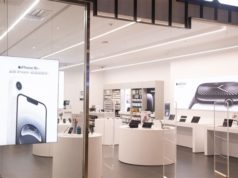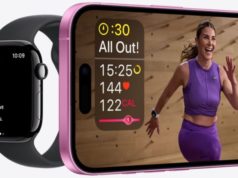Working with noted computer researcher/hacker Andrew “Bunnie” Huang, National Security Agency (NSA) whistleblower Edward Snowden has created a design for an “introspection engine” that detects unwanted radio signals from attached iPhones. They envision the device could be used by journalists who want to ensure their iPhones don’t reveal information about their locations when in airplane mode.
Snowden (pictured above), the former NSA contractor who in 2013 provided journalists with classified information about widespread government surveillance on citizens, described the device today during a presentation with Huang at a Massachusetts Institute of Technology Media Lab event. It was the first time that Snowden, who currently lives in exile in Russia, presented original research at a U.S. university.
In the research paper, “Against the Law: Countering Lawful Abuses of Digital Surveillance,” Snowden and Huang explained how they developed the design based on iPhone-related documentation and parts purchased at an electronics market in China. While their design was created specifically with Apple’s iPhone 6 in mind, they said the underlying principles would allow such a device to work with any type of phone.
MIT ‘Forbidden Research’
“Front-line journalists are high-value targets, and their enemies will spare no expense to silence them,” Snowden and Huang said in the research paper, presented today in a day-long, invitation-only symposium on “Forbidden Research” at MIT’s Media Lab event. “Unfortunately, journalists can be betrayed by their own tools. Their smartphones are also the perfect tracking device.”
While in Hong Kong in 2013, Snowden famously asked journalists Glenn Greenwald and Laura Poitras to remove their cellphone batteries and store them in a hotel refrigerator to avoid concerns about unwanted surveillance. He made similar requests of attorneys he met with during his stay in Hong Kong.
“Because of the precedent set by the U.S.’s ‘third-party doctrine,’ which holds that metadata on such signals enjoys no meaningful legal protection, governments and powerful political institutions are gaining access to comprehensive records of phone emissions unwittingly broadcast by device owners,” Snowden and Huang said in their paper. “This leaves journalists, activists, and rights workers in a position of vulnerability. This work aims to give journalists the tools to know when their smartphones are tracking or disclosing their location when the devices are supposed to be in airplane mode.”
Unwanted Surveillance ‘Endangers Reporters’
Surveillance agencies that use technology to spy on mobile phones despite their owners’ precautions can put reporters and others in danger, Snowden and Huang noted in their research. They cited the example of international journalist Marie Colvin, who was killed in 2012 in an attack by the Syrian government after intercept devices identified her location.
Snowden and Huang plan to create a prototype of their design over the coming year to verify the device can work as intended. If successful, the Freedom of the Press Foundation they are working with could look for ways to develop such a device commercially and provide it to any journalist in a high-risk situation.
In a separate action today, Huang said he is enlisting the help of the Electronic Frontier Foundation, a civil rights advocacy organization, to sue the U.S. government over certain provisions of the Digital Millennium Copyright Act. The lawsuit challenges DMCA restrictions on the development of software based on lawfully purchased, copyrighted material.
Before the DMCA was enacted 18 years ago, “we had the right to tinker with gadgets that we bought, we had the right to record TV shows on our VCRs, and we had the right to remix songs,” Huang wrote today on his blog. “Section 1201 built an extra barrier around copyrightable works, restricting our prior ability to explore and create.”






